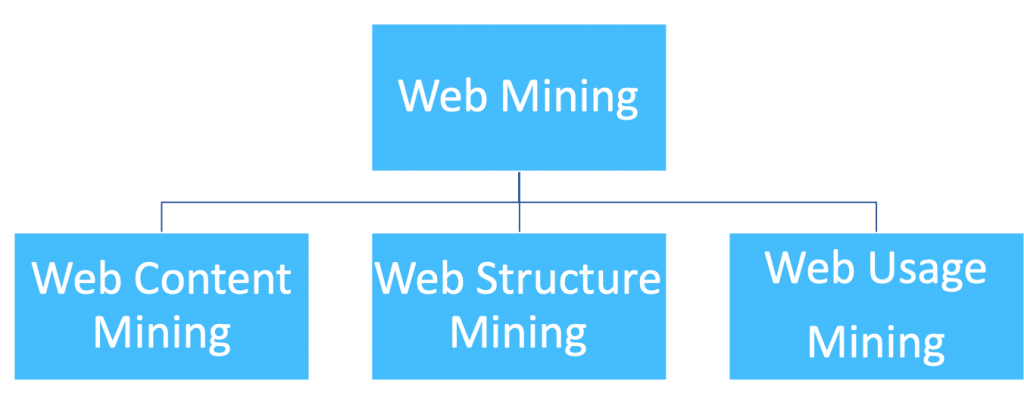Table of Contents
Web mining is a process of extracting useful information from web pages and other online resources. It involves the use of data mining techniques to automatically discover patterns, trends, and insights from web-based data sources. Web mining is widely used by businesses, researchers, and government agencies to gain insights into customer behavior, market trends, and other valuable information.
Types of Web Mining
There are three main types of web mining
- Web Content Mining,
- Web Structure Mining, and
- Web Usage Mining.

- Web Content Mining: Web content mining is the process of extracting useful information from the content of web pages. It involves the use of text mining techniques to analyze the textual content of web pages, including keywords, topics, and sentiment analysis. For example, an e-commerce website may use web content mining to analyze customer reviews and feedback to identify areas for improvement in their products or services.
- Web Structure Mining: Web structure mining is the process of analyzing the link structure of the web. It involves the use of graph mining techniques to analyze the relationships between web pages, including page ranking, clustering, and community detection. For example, search engines use web structure mining to rank web pages based on their relevance and popularity.
- Web Usage Mining: Web usage mining is the process of analyzing user behavior on the web. It involves the use of data mining techniques to analyze user data, including clickstream data, user sessions, and navigation patterns. For example, an online retailer may use web usage mining to analyze customer browsing and purchasing behavior to identify trends and patterns.
Example of Web Mining
Let’s consider the example of a news website that wants to improve its user engagement by providing personalized content to its readers. The website can use web mining techniques to analyze user behavior and interests based on their browsing history and article preferences. The website can use web content mining to analyze the text of the articles that the user reads and identify the topics and keywords that are most relevant to them. The website can also use web usage mining to analyze the user’s clickstream data and identify their browsing and reading patterns. The website can then use this information to provide personalized recommendations to the user, such as articles that are similar to the ones they have read before or articles that are currently trending in their areas of interest.
Tools For Web Mining
There are several tools available that can be used for web mining. Here are some popular ones:
- BeautifulSoup: It is a Python library that is used for web scraping. It can parse HTML and XML documents, and it makes it easy to navigate and extract data from web pages.
- Scrapy: It is a Python framework for web scraping. It provides a complete set of tools for extracting structured data from websites.
- Selenium: It is a tool used for automating web browsers. It is commonly used for web testing, but it can also be used for web scraping and web mining.
- RapidMiner: It is a data mining software that can be used for web mining. It provides a user-friendly interface for building data mining workflows.
- KNIME: It is an open-source data analytics platform that can be used for web mining. It provides a graphical user interface for building data mining workflows.
- Weka: It is an open-source machine learning software that can be used for web mining. It provides a collection of algorithms for data mining and machine learning.
- Apache Nutch: It is an open-source web crawler that can be used for web mining. It can be used to crawl and index web pages, and it provides a plugin architecture for extending its functionality.
These tools can be used to perform various web mining tasks, such as web content mining, web structure mining, and web usage mining. Each tool has its strengths and weaknesses, and the choice of tool depends on the specific requirements of the web mining task.
Conclusion
Web mining is a powerful tool for analyzing web-based data sources and extracting valuable insights and information. By using web mining techniques, businesses, researchers, and government agencies can gain a deeper understanding of customer behavior, market trends, and other important data. With the increasing amount of web-based data being generated every day, web mining is becoming an essential tool for anyone who wants to gain a competitive edge in their industry.
